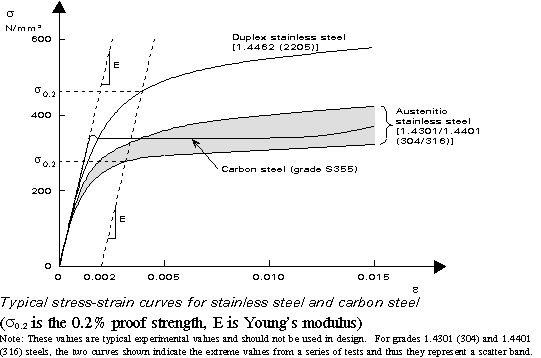Comparison Structural Design Stainless Steel and Carbon Steel
Stress-strain behaviour of carbon steel and stainless steel
The stress-strain behaviour of stainless steel differs from that of carbon steel in a number of respects. The most important difference is in the shape of the stress-strain curve. Whereas carbon steel typically exhibits linear elastic behaviour up to the yield strength and a plateau before strain hardening, stainless steel has a more rounded response with no well-defined yield strength.
Comparison of structural behaviour of stainless steel and carbon steel members
The main reasons for the difference in structural behaviour between carbon and stainless steel members are:
The stress-strain curve for stainless steel departs from linearity at a much lower stress than that for carbon steels
Stainless steels have greater ductility and a greater capacity for work hardening than carbon steels
The material modulus of stainless steel reduces with increasing stress, unlike that of carbon steels which is constant
The residual stresses arising from fabrication are higher in stainless steel than in carbon steel.
As a result of this, different buckling curves are required from those of carbon steel. This applies to:
local (plate) buckling for elements in compression
flexural, torsional, torsional-flexural buckling for members subject to axial compression
lateral-torsional buckling for beams with unrestrained compression flanges
Design guidance for structural stainless steel is available (see References).
 Stainless steel yield strength are generally quoted in terms of the 0.2% proof strength, i.e. the proof strength at an offset permanent strain of 0.2%.
Stainless steel yield strength are generally quoted in terms of the 0.2% proof strength, i.e. the proof strength at an offset permanent strain of 0.2%.
Comparison of mechanical properties for stainless steel and carbon steel
No limitations on thickness in relation to brittle fracture apply to stainless steel; the limitations for carbon steel are not applicable due to the superior toughness of stainless steel. The austenitic stainless steel grades do not show a ductile-brittle impact strength transition as temperatures are lowered. Stainless steel can absorb considerable impact without fracturing due to their excellent ductility and their strain-hardening characteristics.
Estimation of deflections
As the stiffness of stainless steel decreases as the stress level increases, deflections are greater that those for carbon steel members. It is therefore necessary to use a reduced modulus to predict the behaviour of members in which high stresses occur. This is explained in the article Calculating the deflections of stainless steel beams
Comparison Structural Design Stainless Steel and Carbon Steel
Calculating the Deflections of Stainless Steel Beams
Structural Design of Stainless Steel
Stainless Steel Section for Structural Application
Structural Steel Comparison Table
ASTM Standards for Structural Tubing Mechanical Tubing Welded Fitting
1008 | 1010 | 1015 | 1018 | 1020 | 1025 | 1035 | 1040 | 1045 | 1050 | 1117 | 1141 | 1144 | 12L14 | 1215 | 4140 | 4150 | 4340 | 8620 | A36 | A653 | A513
Pipes Tubes Plates Bars Square Tubes Weight Calculation Calculator
Conversion Calculator Calculation-Pressure|Weight|Temperature|Volume|Length
Pipe Working Pressure Calculation
Metals Weight Calculator Calculation
|
